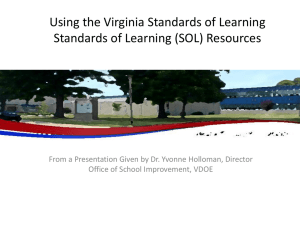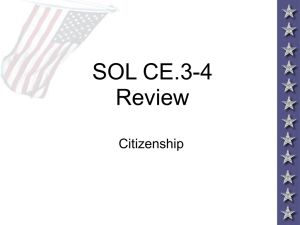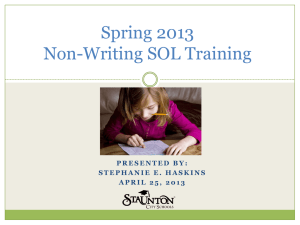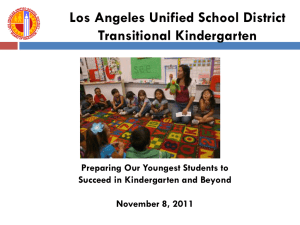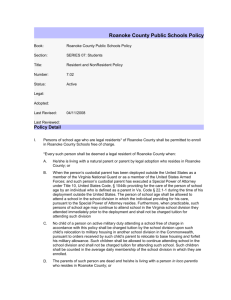United Way PowerPoint Presentation Template
advertisement
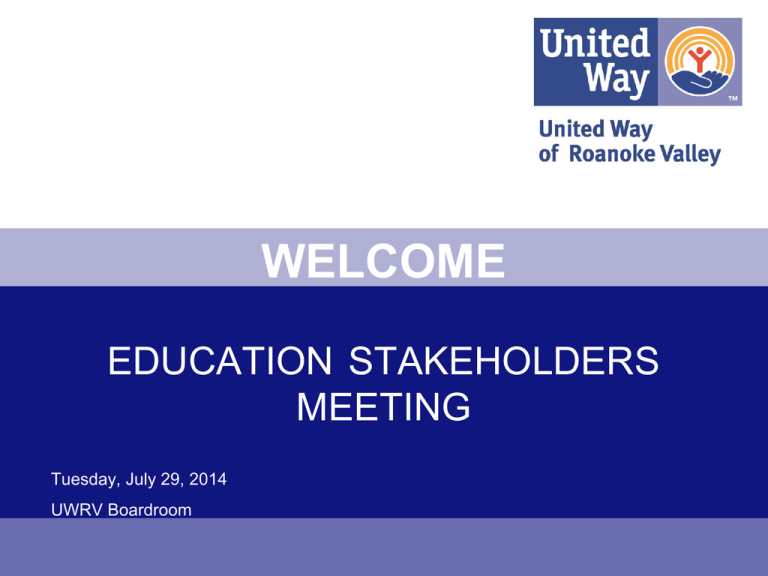
WELCOME EDUCATION STAKEHOLDERS MEETING Tuesday, July 29, 2014 UWRV Boardroom • The Statistics Lottery 2 Education, Income, and Health • Continuous assessment of the community • Sustainable results in Education, Income, and Health • Partnership opportunity with funds that will be raised through the 2014 United Way campaign, specifically with dollars directed to Impact Fund • We appreciate your support of the 2014 United Way campaign 3 UWRV’s Direction • UWRV makes strategic investments in our community with the ultimate goal of improving people’s lives, both by helping individuals and by creating community level change. • Our strategies include community collaborations, advocacy for public policy changes, and investing financial resources in programs provided by impact partners. 4 Partnering to Move the Needle A Cradle to Career Approach to Education 6 United Way Education Priorities Goal: Increase the number of children aged 0-5 in the Roanoke Valley that arrive prepared for the first day of kindergarten as determined by tangible measurement tools. Outcome #1: Parents of children 0-5 are able to access affordable quality out-of-home care and education for their children. Outcome #2: Parents of children 0-5 become more committed, confident and skilled in helping their children be prepared for school. Outcome #3: Community leaders and the public understand the cost and benefits of, and actively support, early childhood care and education both from the social service and economic development standpoints. United Way Education Priorities Goal: Contribute to the statistically significant improvement of the graduation rates within Roanoke Valley by enabling students and their families to be better prepared to take advantage of the opportunities provided by public education. Outcome #1: Students are able to read and comprehend by the end of third grade. Outcome #2: Students are connected with help that they need to stay in school beginning at an early age. From Isolated to Collective Impact 9 Valley-wide Data Overview July 29th, 2014 United Way Roanoke Valley Education Open Process Stakeholders Meeting A recent, March 2013, research project out of Montgomery County Public Schools in Maryland has identified student characteristics relating to dropping out of high school that start as early as the 3rd marking period of 1st grade. Early Warning Indicators 1st grade, MP3 3rd grade, MP1 6th grade, MP1 Absent from… school 9 or more times school 3 or more times a class 3 or more times Suspended… [either ISS/OSS] 1 or more times 5x 1 or more times 9x 1 or more times Is.. below grade level in reading/math Has earned a calculated GPA below a…. 1.20 [D] below grade level in reading/math; earning a D or below in non-timely with Homework English or Math class completion 3.00 [B] 3.00 [B] 5x Free and Reduced Percentage 45% 44% 43% 42% 41% Valley-wide 40% Commonwealth 39% 38% 37% 36% Oct. '09 Oct. '10 Eligibility Generalities TANF, SNAP, Oct. '11 Oct. '12 Oct. '13 # people annual household income 2 28,694 3 36,131 4 43,568 Percentage & number of each Valley-wide Kindergarten cohort not meeting Fall Kindergarten PALS Benchmark 16.0% 15.6% 15.3% 14.8% 14.5% 13.8% 13.6% 13.0% 427 373 415 387 423 Fall '09 Fall '10 Fall '11 Fall '12 Fall '13 8.5x QUICK In Spring ‘13, Virginia implemented more rigorous Reading SOL assessments that were conducted, for the first time, entirely online. The tests included technology enhanced items (TEI) that required students to use more critical thinking skills and solve multi-step problems. The following are a few sample items from the Grade 3 Reading SOL test. a sampling of the assessed skills… Grade 3 Reading Grade 3 Mathematics Use knowledge of : prefixes, suffixes, Estimate and use US Customary and antonyms, synonyms, homophones metric units for length, liquid and “roots” volume, & weight/mass measures Identify and describe : fiction and non-fiction; story specific…characters, main idea, problem/solution, setting & supporting details Describe, compare/contrast the angles, vertices, faces and edges of the following shapes : cube, square pyramid, sphere, cone, & cylinder Ability to explain the differences between…table of contents, charts, captions, dictionaries, glossaries, indices & online resources Sum or difference of two whole numbers up to 9,999 ; add or subtract proper fractions having like denominators of 12 or less Valley-wide Pass Rates on Grade 5 Reading, Mathematics & Science SOL Tests 100% 95% 90% Spring '10 85% 80% 79.87% 79.20% 76.04% 75% Spring '11 Spring '12 Spring '13 75.47% Virginia 73.10% 70% 68.80% 65% Grade 5 Reading Grade 5 Mathematics Grade 5 Science In Spring ‘12, Virginia implemented a more rigorous Mathematics SOL assessment. In Spring ’13, more rigorous Reading and Science SOL assessments were administered. Valley-wide Pass Rates on Grade 8 Reading, Mathematics & Science SOL Tests 100% 90% 79.86% 80% 76.31% 70.69% Spring '11 Spring '12 75.99% 70% Spring '10 Spring '13 Virginia 69.75% 61.42% 60% Grade 8 Reading Grade 8 Mathematics Grade 8 Science In Spring ‘12, Virginia implemented a more rigorous Mathematics SOL assessment. In Spring ’13, more rigorous Reading and Science SOL assessments were administered. Virginia’s On-Time Graduation Rate as a function of cohort year and division 100 95 90 89.2 86.9 89.0 Botetourt County 85 85.7 85.8 Craig County 83.3 Roanoke City Roanoke County 80 Salem City Valley-wide 75 Virginia 70 65 2010 2011 2012 2013 ANOTHER QUICK Number of Passing SOL Tests in order to earn each respective diploma Standard Advanced Diploma Diploma English Grade 11 Reading Grade 11 Reading 2 Grade 11 Writing Grade 11 Writing 2 Algebra I Geometry Algebra 2 Algebra I 1 Geometry Algebra 2 Science Earth Science Biology Chemistry Earth Science Biology 1 Chemistry History World Geography World Geography World History 1 World History 1 World History 2 1 World History 2 2 VA & US History VA & US History Mathematics Student Selected total < see above > 6 1 < see above > 9 2 2 1 Valley-wide percentage of each population grade range subset that was retained as a function of school year (SY) 6% 5.4% 5% 3.8% 4% 3% 2.1% 2% 1% 1.0% 0.8% 0.6% 341 0% SY 09-10 SY 11-12 Elementary School 54 SY 09-10 SY 11-12 Middle School 607 SY 09-10 SY 11-12 High School Valley-wide Percentage of Population with whom a Truancy Conference was held as a function of school year (SY) 11% 10.6% 10% 10.0% 9.9% 9% 8.2% 8% SY 09-10 SY 10-11 SY 11-12 SY 12-13 Final High School Outcomes by 10th Grade Absenteeism Post Secondary source: The Importance of Being in School : A Report on Absenteeism in the Nation’s Public Schools; May ‘12 Valley-wide percentage of each student population subset that was suspended, out-of-school, as a function of school year (SY) 14% 12% 10% 9.43% 8.31% 8% SY 09-10 SY 10-11 5.98% 6% SY 11-12 SY 12-13 4% 2.67% Elementary Middle 2226 1031 685 0% 470 2% High ALL 44.5x 53% percent of ALL the discipline related offenses for the past 5 years, Valley-wide, were related to Behavior Granular breakdown of Valley-wide Behavior-related offenses 9% 30% 13% Insubordination Classroom Disruption Using Obscene Lang/Gestures Disrespect of Authority 13% Minor Insubordination Disruptive Demonstration 15% 20% Unwillingness to submit to authority or refusal to respond to a reasonable request. Any act that intentionally disrupts the orderly conduct of a school function. Any behavior that substantially disrupts the orderly learning environment. Middle School Risky Behaviors High School Risky Behaviors College and Career – Virginia Western Community College • 57% of students receive financial aid / 79% receive Pell grants • CCAP • # of college-goers who go through Virginia Western • Self-sufficiency and academic success skills • 50% need developmental courses – 40% math, 20% English • Services for: 1st generation, disability, low-income, veteran, or 50+ 26 Toddler Steps: Continuing to Work Towards Equal Footing in Early Education Presentation to the United Way of Roanoke Valley May 6, 2014 Memorandum of Understanding (MOU) A sampling of additional topics of analysis • Types of programs • Types of services • Family and child characteristics • Attendance records • Grade retention • Special education Working together to: Scrub and validate data Join data sets Analyze and report data Inform conversations Make data-based decisions early childhood characteristics school-age characteristics and assessment results high quality instruction, enhanced professional development, & accountability implementation steps reporting partner data locating & joining data sets analysis & continuous improvement Project Milestones [Nov.2013-Apr.2014] Fall 2013 cohort analysis Risk factor work and summarization Expansion to include Smart Beginnings Greater Roanoke, Botetourt & Salem school systems FALL PALS Kindergarten Performance as a function of aggregate number of risk factors 100 80 10 100.0 60.0 11 100.0 63.6 84.4 57.1 9 78.7 100.0 7 66.7 100.0 2 40 86.1 100.0 60 1 1 0.0 20 0 0 factors 72 1 factors 12 75 2 factors CHIP 7 32 3 factors 4 factors 2 5 factors - 6 factors TAP HeadHead StartStart Spring 2013 cohort. The risk factors: parent mental health, homeless, referral source/discharge reason(CHIP), food/clothing assistance (TAP Head Start), substance abuse, dual language learner, child abuse, economic status, and parent education level. SBGR K-Readiness AY 2013-2014 Fall 2013 # K Students Enrolled % Ready for K* # Not Ready for K* Botetourt County Craig County 279 91% 24 45 77% 10 Roanoke City 1253 79% 261 Roanoke County Salem City 1011 90% 102 270 90% 26 VA DOE Enrollment Kidscount.org SBGR K-Readiness AY 2013-2014 Fall 2013 Roanoke City VSQI/Roanoke City # K Students Enrolled % Ready for K* # Not Ready for K* 1253 111 79% 88% 261 13 a few preliminary findings Students who started at CHIP closer to their birth date did BETTER on the K PALS assessment when compared to those who started later. additional topics of analysis Risk factors & Academic performance [ TAP Head Start ] Age at enrollment Length of enrollment Services Received [ VSQI ] [ CHIP ] Discussion Questions As a group: • What data is relevant to your students/clients? What evidence-based strategies does your program use to help move that needle? • What opportunities are there to connect and complement each other’s work? • What would you need to do after this meeting to make this happen? 40 Education Open Process • Opportunity to partner with United Way • Open to nonprofit organizations meeting one of UW’s education outcomes • Process is competitive and uses zero-based funding • Partners funded should commit to engaging in data tracking • Applications are reviewed by community volunteers 41 Program Review Criteria Administrative Review – pass/fail 42 Key Dates to Remember • Education Service Providers Meeting – July 29 • Sign-ups to submit Letter of Intent - September 3 - October 1 @ noon • Logic Model/Outcome Workshop – September 16, 3:30 – 5 pm • Letter of Intent open - October 1 - 17 • Application Workshops - November 4, 3 - 5pm • Invitations to aligned programs - November 17 • Data Tracking Workshops – December 4, 3 - 5pm • Administrative and Program Applications – December 15, 2014– January 23, 2015 @ noon • Site visits and panel questions: February – March 2015 – Panel questions will be submitted to the programs via e-cImpact and programs should respond before the scheduled site visit – Site visits are targeted to occur from February 16 – March 6, 2015 • Funding Award Letters – May 6, 2015 • Signed MOUs due to United Way – May 20, 2015 43 Helping the students via a continuous improvement cycle of data analysis Act Analyze Microsoft Excel Assess Microsoft Excel Conditional Formatting & Sorting & Filtering & Pivot Tables & Q&A 46 THANK YOU ALL FOR COMING! We’re looking forward to hearing more about these great ideas and seeing great Letters of Intent this October! 47
